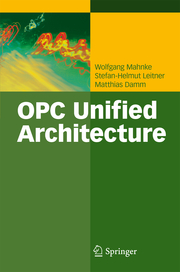Detailansicht
OPC Unified Architecture
ISBN/EAN: 9783540688983
Umbreit-Nr.: 1994276
Sprache:
Englisch
Umfang: xxiii, 339 S., 177 s/w Illustr., 339 p. 177 illus.
Format in cm: 2.4 x 24 x 16.2
Einband:
gebundenes Buch
Erschienen am 19.03.2009
Auflage: 1/2009
- Zusatztext
- Motivation for This Book The OPC Foundation provides specifications for data exchange in industrial au- mation. There is a long history of COM/DCOM-based specifications, most pro- nent OPC Data Access (DA), OPC Alarms and Events (A&E), and OPC Historical Data Access (HDA), which are widely accepted in the industry and implemented by almost every system targeting industrial automation. Now the OPC Foundation has released a new generation of OPC specifications called OPC Unified Architecture (OPC UA). With OPC UA, the OPC Foundation fulfills a technology shift from the retiring COM/DCOM technology to a servi- oriented architecture providing data in a platform-independent manner via Web Services or its own optimized TCP-based protocol. OPC UA unifies the previous specifications into one single address space capable of dealing with current data, alarms and events and the history of current data as well as the event history. A remarkable enhancement of OPC UA is the Address Space Model by which v- dors can expose a rich and extensible information model using object-oriented techniques. OPC UA scales well from intelligent devices, controllers, DCS, and SCADA systems up to MES and ERP systems. It also scales well in its ability to provide information; on the lower end, a model similar to Classic OPC can be used, providing only base information, while at the upper end, highly sophisticated models can be described, providing a large amount of metadata including complex type hierarchies.
- Kurztext
- The OPC Foundation defines standards for online data exchange between automation systems. They address access to current data (OPC DA), alarms and events (OPC A&E) and historical data (OPC HDA). Those standards are successfully applied in industrial automation. The new OPC Unified Architecture (OPC UA) unifies the existing standards and brings them to state-of-the-art technology using service-oriented architecture (SOA). Main advantages of the new standard are: Platformindependent technology allows the deployment of OPC UA beyond current OPC applications only running on Windowsbased PC systems. OPC UA can also run on embedded systems as well as Linux / UNIX based enterprise systems. The provided information can be generically modeled and therefore arbitrary information models can be provided using OPC UA. This book gives an easy to understand introduction into OPC UA and explains the concepts of the standard and other relevant topics that are not directly addressed by the standard.
- Autorenportrait
- InhaltsangabeInformation Modeling: Concepts.- Information Modeling: Example and Best Practice.- Standard Information Models.- Services.- Technology Mapping.- Security.- Application Architecture.- System Architecture.- Mapping of COM OPC to OPC UA.- Migration.- Profile.- Performance.- Conclusion and Outlook.- Literature.
